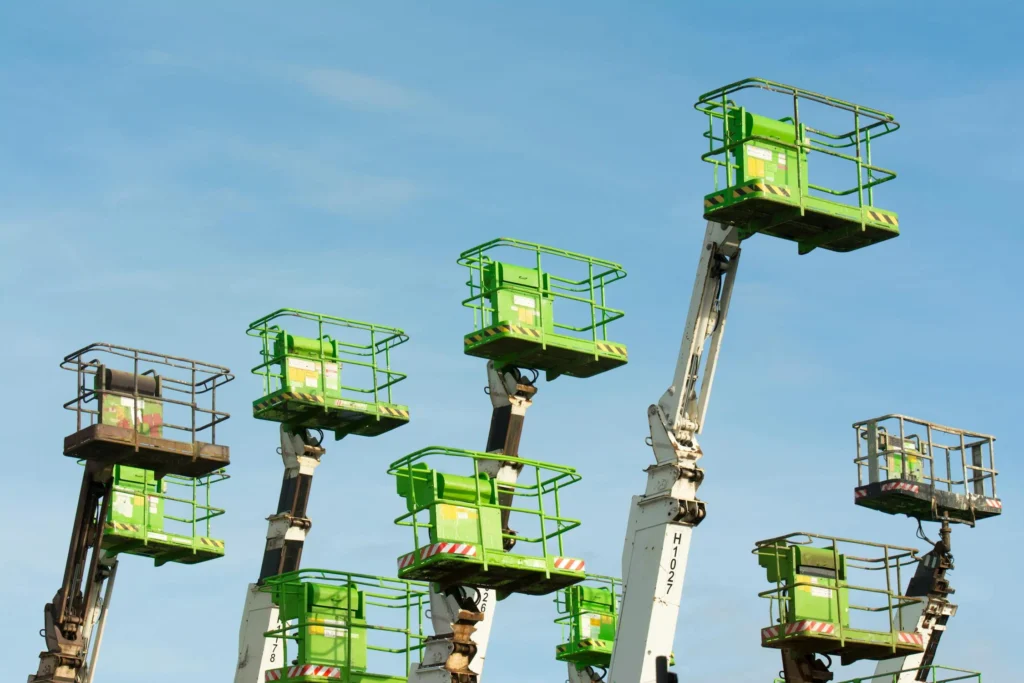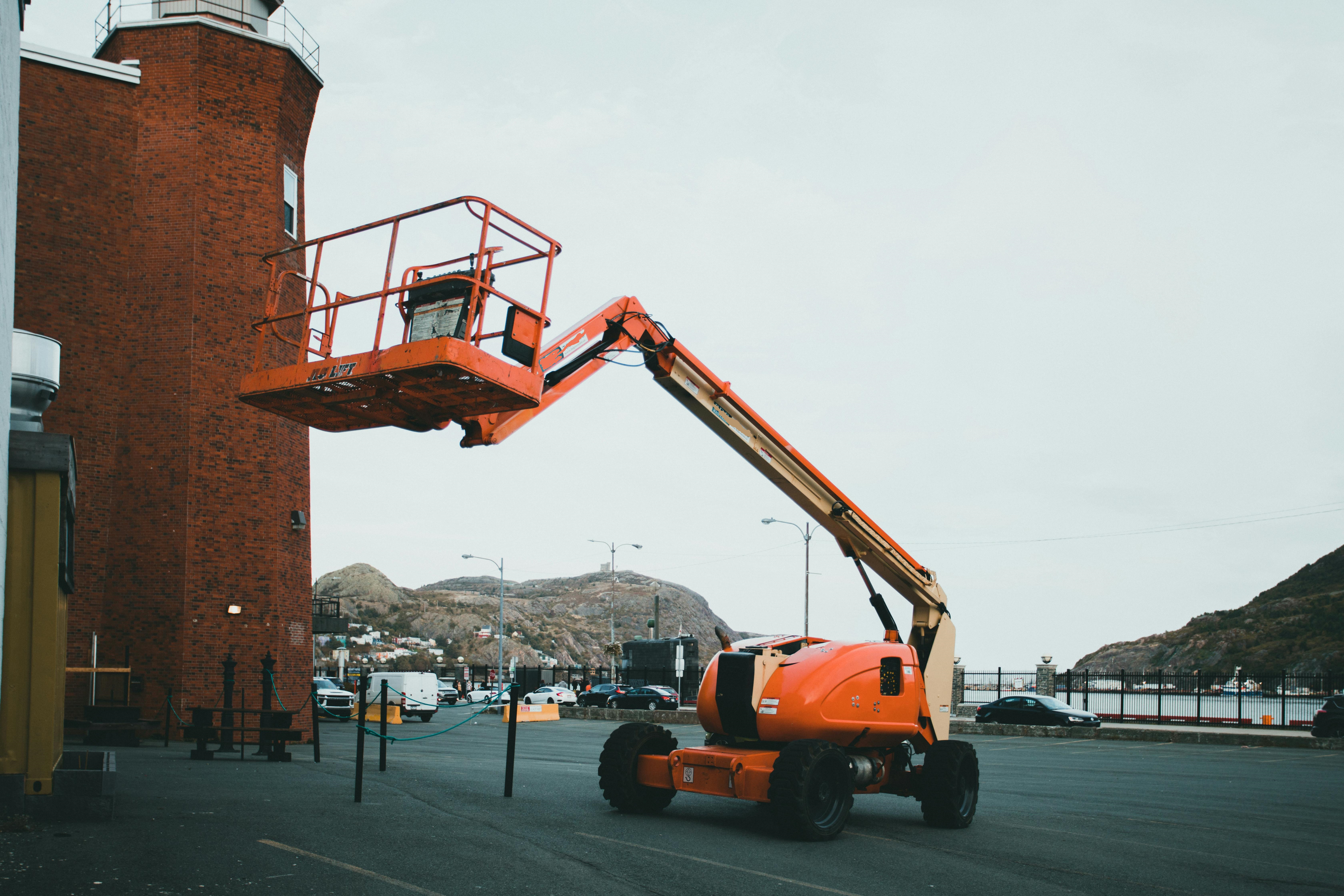
Boom lifts are essential pieces of equipment used across various industries to provide safe, efficient vertical access for workers. These versatile machines enable workers to reach significant heights with precision and safety, making them crucial in construction, maintenance, industrial, and event setup applications.
Are you looking to rent a boom lift for your next construction or maintenance project? Understanding where to rent a boom lift and the associated rental prices can significantly impact your project’s success. In this comprehensive guide, we’ll walk you through everything you need to know about boom lift rental to make an informed decision.
Some of the Industry Applications of Boom Lift Rental are as follows:
- Construction: Structural work , building maintenance, installation services, exterior painting
- Industrial Maintenance: Equipment repair, Facility maintenance,Infrastructure inspection,Electrical line work
- Event Management: Stage setup, Lighting installation,Venue preparation,Temporary structure assembly
- Agricultural Sector: Orchard maintenance, crop inspection, greenhouse management, structural repairs
Understanding Boom Lift Rental: Key Features and Benefits
Boom lift rentals offer a flexible, cost-effective solution for accessing elevated work areas. By understanding the various types, features, and considerations, businesses can make informed decisions that enhance productivity and safety. When it comes to selecting the appropriate boom lift rental, there are a few key steps to follow:
- Evaluate Your Project Specifications
Assess the unique needs of your project, focusing on the following factors:
- Working Height and Reach: Determine the maximum height and horizontal reach required.
- Load Capacity: Identify the weight the lift needs to support, including tools and materials.
- Site Accessibility: Consider the terrain and space constraints at the project location.
Boom lifts are available in two main configurations:
- Battery-Powered Lifts: Best suited for indoor use, offering zero emissions, quiet operation, and reduced maintenance.
- Engine-Powered Lifts: Ideal for outdoor projects and rough terrain, providing higher power, greater load capacity, and extended operational durations.
- Match Boom Lift Capabilities to Your Needs
Once your project requirements are clear, match them to available boom lift models and their specifications:
- Boom Length: Ensure the lift can reach the required working height and extension.
- Lift Capacity: Confirm the lift supports the necessary weight.
- Maneuverability: Evaluate the equipment’s ability to navigate tight spaces or challenging terrain.
- Explore Additional Features and Attachments
Optimize the boom lift for your specific tasks by considering available accessories:
- Material Handling Equipment: Simplify carrying tools and supplies.
- Specialized Platforms: Enhance safety and efficiency for unique tasks.
Additionally, consider complementary equipment to improve overall project efficiency:
- Generators(insert-how-to-choose-right-generator-blog-link): Provide essential power for remote or undeveloped job sites.
- JCBs: Offer versatile solutions for digging and material handling.
These tools, combined with a well-matched boom lift, can create a comprehensive setup for even the most complex project needs.
- Consult with Rental Experts: Engage with the rental provider’s team to discuss your project requirements and get their professional recommendations. Their expertise can be invaluable in ensuring you select the most suitable boom lift for the job.
Where to Rent a Boom Lift: Finding the Right Provider

Selecting the right boom lift rental provider is crucial for ensuring project success, safety, and cost-effectiveness. This comprehensive guide will help you navigate the process of finding the best rental source for your specific needs.
Recommended step by step Evaluation Process to select the right provider :
- Initial Research : Online reviews, industry recommendations , professional network referrals.
- Preliminary Screening : Verify business credentials , check insurance coverage ,assess equipment inventory.
- Detailed Consultation : Discuss specific project requirements, request equipment demonstrations , clarify all rental terms.
- Final Verification : Check references, confirm technical support capabilities , review rental agreement thoroughly.
- Experience and Reputation: Look for providers with extensive industry experience and positive customer testimonials.
- Equipment Maintenance Records: Regular maintenance logs indicate well-maintained equipment that’s less likely to break down.
- 24/7 Support Availability: Ensures immediate assistance for any equipment issues or emergencies during your rental period.
- Delivery and Pick-up Services: Convenient transportation services save you time and logistics management efforts.
- Safety Certifications: Proper certifications demonstrate commitment to industry safety standards and regulations.
- Insurance Coverage: Comprehensive insurance policies protect against potential accidents or equipment damage.
- On-site Technical Support: Access to skilled technicians for equipment setup, training, and troubleshooting.
Understanding Boom Lift Rental Prices: What to Expect
Boom lift rental prices can vary widely depending on multiple factors.
- Duration of Rental: Longer rental periods typically qualify for better daily rates and discounted packages.
- Type and Size of Boom Lift: Larger units with greater reach capabilities command higher rental rates.
- Season and Demand: Peak construction seasons may affect availability and pricing structures.
- Location: Service area and delivery distance impact overall rental costs.
- Additional Services: Optional features like operator training and specialized attachments affect final pricing.
Factors Affecting Boom Lift Rental Prices
Boom lift rental prices are influenced by a complex array of factors that can significantly impact the overall cost. Understanding these elements can help businesses and contractors make more informed decisions when budgeting for aerial work platform rentals.Boom lift rental pricing is a multifaceted calculation involving equipment specifications, market dynamics, service levels, and individual project requirements. By understanding these factors, businesses can make strategic decisions that balance cost-effectiveness with operational needs.
- Project Duration: Time requirements influence pricing tiers and potential discount opportunities.
- Equipment Specifications: Advanced features and specialized capabilities affect the base rental rate.
- Rental Terms and Conditions: Contract details including damage coverage and overtime charges impact total cost.
- Insurance Requirements: Necessary coverage levels and additional insurance riders affect overall expenses.
- Fuel and Maintenance Costs: Operating expenses vary based on equipment type and usage patterns.
- Delivery and Pick-up Fees: Transportation costs depend on project location and equipment size.
- Training Requirements: Operator certification and training needs may add to the total rental package.
- Supplementary Equipment : Safety harnesses, additional attachments, specialized work platforms, each accessory incrementally increases the total rental price.
- Fuel Type Impact : Diesel lifts generally more expensive than electric models.Hybrid and advanced technology lifts command premium pricing. Eco-friendly options may have different pricing structures.
- Seasonal Demand : Peak construction seasons drive up rental prices. Winter and off-peak seasons may offer more competitive rates. Regional climate and construction cycles impact pricing.
- Equipment Condition and Age : Newer equipment typically costs more to rent. Well-maintained lifts command higher prices. Advanced models with recent technological upgrades are priced at a premium.
- Maintenance History : Lifts with comprehensive maintenance records may have slightly higher rates .Reliable equipment justifies marginally increased pricing.
- Technology Features : GPS tracking , advanced safety systems, Digital monitoring capabilities,computerized diagnostic tools, these technological enhancements increase rental costs.
How to Choose the Right Boom Lift for Your Project

Selecting the appropriate boom lift is crucial for ensuring project efficiency, safety, and cost-effectiveness. This comprehensive guide will walk you through the critical considerations in choosing the right boom lift for your specific needs.
- Working Height Requirements: Calculate maximum height needs including any overhead clearance requirements.
- Horizontal Reach Needs: Consider outreach requirements for accessing hard-to-reach areas safely.
- Indoor vs. Outdoor Use: Environment determines the need for electric or diesel-powered equipment.
- Surface Conditions: Ground stability and terrain type influence the selection of appropriate tires or tracks.
- Load Capacity: Factor in combined weight of workers, tools, and materials for safe operation.
- Power Source: Choose between electric models for indoor use or diesel options for outdoor applications.
- Space Constraints: Consider machine dimensions and turning radius for site accessibility.
Safety Considerations When Renting a Boom Lift
Safety is paramount when working with boom lifts. This comprehensive guide will outline critical safety considerations to protect workers, equipment, and project integrity.
- Operator Training and Certification: Ensure all operators meet OSHA requirements and manufacturer specifications.
- Site Assessment and Planning: Evaluate workspace for potential hazards and access restrictions.
- Weight Restrictions and Load Capacity: Strictly adhere to manufacturer’s specified weight limits and load distribution guidelines.
- Weather Conditions: Monitor wind speeds and weather forecasts for safe outdoor operation.
- Regular Equipment Inspections: Perform daily checks of all safety systems and mechanical components.
- Emergency Protocols: Establish clear procedures for equipment malfunction or operator emergency.
- Personal Protective Equipment (PPE): Require proper safety gear including harnesses and hard hats.
- Clear Communication Procedures: Maintain open channels between ground crew and elevated workers.
Conclusion
Renting a boom lift can significantly enhance your project’s efficiency and safety when done correctly. By understanding rental prices, selecting the right provider, and following proper safety protocols, you can ensure a successful rental experience.
At Clexen Rentals, we offer a comprehensive range of boom lifts suitable for various applications, backed by our commitment to quality, safety, and customer satisfaction. Our 24/7 support ensures you have the assistance you need, when you need it. Whether you’re working on construction, maintenance, or telecommunications projects, we have the right equipment to meet your needs.
Boom lift rental requires careful planning, thorough research, and a comprehensive understanding of your project’s specific needs. By considering equipment specifications, safety requirements, and cost factors, you can ensure a successful and efficient rental experience.
Contact our team today to discuss your boom lift rental requirements and receive a customized quote tailored to your project specifications. With our extensive fleet and experienced support staff, we’re ready to help you elevate your project to new heights – literally!
